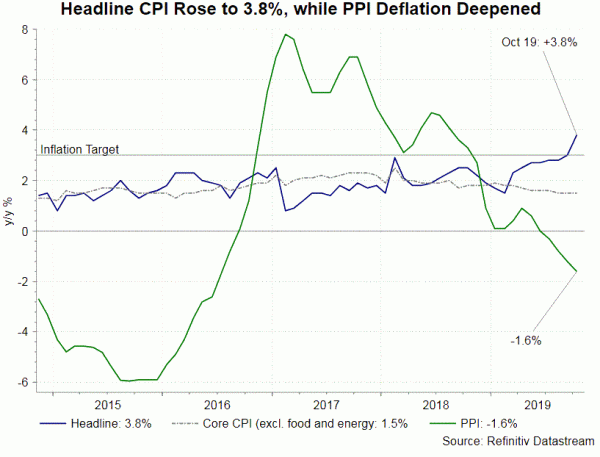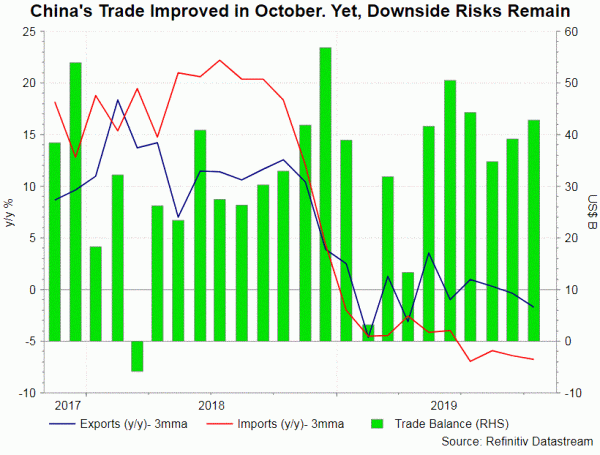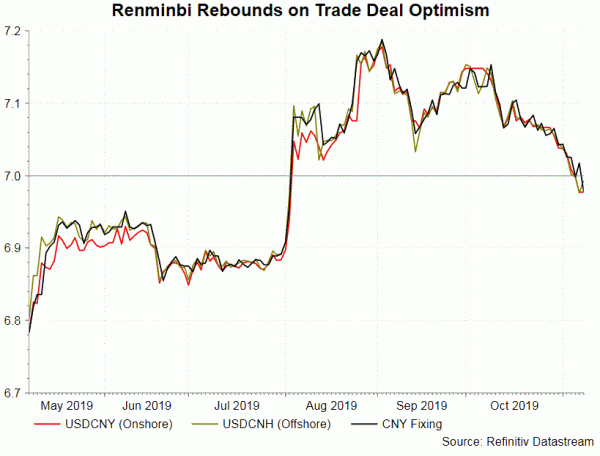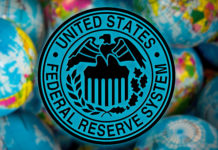Headline CPI in China accelerated further to +3.8% y/y in October. This had exceeded consensus of +3.4% and breached the 3% target for the first time since 2013. Food price, in particular pork price, was again the key driver for the strong inflation. Food inflation soared +15.5% y/y, compared with +11.2% in September. Pork price more than doubled in October, when compared with the same period last year. Fruit price contracted -0.3% y/y, after gaining +7.7% in September. Non-food price eased to +0.9% with fuel cost deflating 15.1% y/y last month. Core inflation remained mild, steadying at +1.5% y/y. On upstream price level, PPI deflation worsened to -1.6% y/y in October, from -1.5% a month ago. Inflation in petroleum and coal mining industry suffered most.
 Separately, trade data showed improvement in both exports and imports. Exports fell -0.9% y/y in October, following a -3.2% decline in the prior month. Imports fell -6.4% y/y, compared with a -8.5% contraction in September. Meanwhile, trade surplus widened to US$42.8B from September’s US$39.6B. Looking at the detailed report, exports to the US rebounded strongly last month, up +4.6% m/m seasonally adjusted. From a year ago, shipment to the US contracted -16.2%, better than the -21.9% decline in September. Exports to ASEAN rebounded +15.8% y/y in October, from +9.7% a month ago. Shipment to the EU climbed +3.1% y/y, following a +0.1% increase. However, exports to Japan contracted -7.8% yoy in October, worsening from -5% in September. Concerning China’s imports of commodities, crude oil declined -9.6% y/y in October, after a -7% contraction in September. ). Copper imports dropped -3.7% y/y, improving from a -18.6% decline in September. Iron ore imports continued to rise. However, growth decelerated to +36.3% yy in October, from September’s +55.8%.
Separately, trade data showed improvement in both exports and imports. Exports fell -0.9% y/y in October, following a -3.2% decline in the prior month. Imports fell -6.4% y/y, compared with a -8.5% contraction in September. Meanwhile, trade surplus widened to US$42.8B from September’s US$39.6B. Looking at the detailed report, exports to the US rebounded strongly last month, up +4.6% m/m seasonally adjusted. From a year ago, shipment to the US contracted -16.2%, better than the -21.9% decline in September. Exports to ASEAN rebounded +15.8% y/y in October, from +9.7% a month ago. Shipment to the EU climbed +3.1% y/y, following a +0.1% increase. However, exports to Japan contracted -7.8% yoy in October, worsening from -5% in September. Concerning China’s imports of commodities, crude oil declined -9.6% y/y in October, after a -7% contraction in September. ). Copper imports dropped -3.7% y/y, improving from a -18.6% decline in September. Iron ore imports continued to rise. However, growth decelerated to +36.3% yy in October, from September’s +55.8%.
 Caixin/Markit PMI report released on November 1 had signaled improvement in China’s exports. The report suggested that the country’s new exports order rebounded for the first time in 5 months in October. It also reached the highest point since February 2018. The report noted that the strength was driven by “US’ move to exempt more than 400 types of Chinese products from additional tariffs”. It is true that market sentiment has improved over the past weeks, amidst optimism of US-China trade deal. We, however, remain cautious about the developments. There remains uncertainty about how a phase one deal will be finalized. Moreover, anticipation of positive trade deal outcome would send renminbi higher. A stronger renminbi could limit attractiveness of Chinese exports.
Caixin/Markit PMI report released on November 1 had signaled improvement in China’s exports. The report suggested that the country’s new exports order rebounded for the first time in 5 months in October. It also reached the highest point since February 2018. The report noted that the strength was driven by “US’ move to exempt more than 400 types of Chinese products from additional tariffs”. It is true that market sentiment has improved over the past weeks, amidst optimism of US-China trade deal. We, however, remain cautious about the developments. There remains uncertainty about how a phase one deal will be finalized. Moreover, anticipation of positive trade deal outcome would send renminbi higher. A stronger renminbi could limit attractiveness of Chinese exports.
 On the monetary policy, elevated inflation has nonetheless limited PBOC’s flexibility to lower interest rates. However, we expect it would continue to cautiously adopt a easing policy in order to boost the economy. The rate cut last week suggested that the central bank has the intention to stimulate the economy. The trivial reduction of 5 bps, however, signaled its concerns about the impact on inflation. PBOC will fix its policy rate lower next week (Nov 20), echoing the rate cut last week.
On the monetary policy, elevated inflation has nonetheless limited PBOC’s flexibility to lower interest rates. However, we expect it would continue to cautiously adopt a easing policy in order to boost the economy. The rate cut last week suggested that the central bank has the intention to stimulate the economy. The trivial reduction of 5 bps, however, signaled its concerns about the impact on inflation. PBOC will fix its policy rate lower next week (Nov 20), echoing the rate cut last week.












